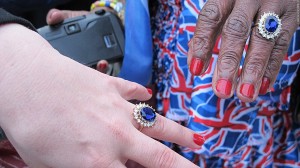So many images flitting across the computer screen from the royal wedding – those absurd hats – fascinators – that find their full flower when royals gather, and the equally ridiculous military uniforms with oversized epaulets, sashes, elaborately braided ropes and boots with spurs. Tin-pot dictators have caricatured this garb many times, decking themselves out in theatrical uniforms to give themselves a veneer of legitimacy. Muammar Gaddafi and the Myanmar leader Than Shwe are pictured below.
hats – fascinators – that find their full flower when royals gather, and the equally ridiculous military uniforms with oversized epaulets, sashes, elaborately braided ropes and boots with spurs. Tin-pot dictators have caricatured this garb many times, decking themselves out in theatrical uniforms to give themselves a veneer of legitimacy. Muammar Gaddafi and the Myanmar leader Than Shwe are pictured below.
Now take a look at the aged Prince Phillip whose uniform is bespangled with so many medals one could only conclude he was either a national war h ero or a caricature of himself. I favor the latter since his job for the last 60 years has been to walk 60 paces behind his wife.
And then of course there was Pippa, the bridesmaid whose virginal white outfit had an endless array of buttons perfectly aligned along her comely bottom i.e. one exquisite ass-of-your-wildest-dreams. 
When I was done snickering at this entertaining ritual, one random crowd shot held my attention. It was an old black hand juxtaposed against a young white hand, and both were wearing cheap knock-offs of the famous sapphire engagement ring. The black fingernails had red fingernail polish, but someone had the shakes when applying it, and the polish had slopped beyond the nail. The polish on the white hand was slightly chipped. The older hand a definite dignity about it; its deep wrinkles contrasted with the shiny thin skin around the nail beds, suggesting a life time of hard physical labor. I imagined that they belonged to a matriarch, who I will call Bea, perhaps someone whose husband had evaporated and was left saddled with too many children and no money, but somehow made it work. The younger hand was unadorned and pale and looked like it had a life time of hard work ahead of it.
I wondered what had brought these two hands together on the streets of London. Was this a totally random crowd shot or did these two hands, which looked like they were at such different places in their lives, actually know each other? Perhaps the younger hand belonged to an immigrant, who I will call Marta. She had come to London from Eastern Europe, but the only work she could find was a miserable minimum wage job at the nursing home where she met Bea. Bea and Marta found a common bond through the love of the royal family. Bea had actually met Princess Diana once at an AIDS clinic that had treated her son in the early days of the AIDS epidemic. She was totally captivated by the Princess whose handshake with her brother made headline news. Bea was devastated when Diana died, and had closely followed Prince William and Harry as a surrogate mother in absentsia. Back home in Bulgaria, Marta had a poster of Prince William over her bed and in fact had come to London with the wild idea of marrying a prince. Bea’s maternal instincts reached out to the forlorn Marta and she suggested that they watch the procession. Marta used some of her meager savings to buy the two ring knock off rings from a street vendor, and each dressed in her fanciest outfit, which for Marta was the only dress that she owned.
As I pondered these two unlikely hands, I realized that I knew the exact foot that could match the older hand. About 30 years ago I was working as a medical school student in a free women’s health care clinic on the west side of Chicago. I was assigned to do pelvic exams and Pap smears in a small examining room separated from the patient’s changing room by a partial wall, similar to adjoining bathroom stalls. I sat on a small stool in my stall and imagined what the next women would look like. My clues were based on the shoes and bare feet that were visible below the partition. There were also the noises that I heard as the women took off their clothes and put on paper gowns. The clients of the clinic fell into three groups – working girls, students from the adjacent nursing school and neighborhood women, who tended to be older black women. The prostitutes tended to wear high heels even in the thick of winter, but typically the shoes were scuffed up or had cracks in the patent leather. I would then hear the quick rasp of a short zippered skirt, or a longer rasp indicating a dress, followed by a swishy sound as the woman shimmied out of the dress and pulled it over her head.
The prostitutes were typically there to be evaluated for sexually transmitted diseases, primarily gonorrhea or chlamydia in that pre-HIV era. I particularly remember one attractive woman, who hoisted herself into the stirrups on the examining table. As I prepared the speculum for the pelvic exam, I was taken aback, to say the least, when I saw that this was a transgender woman who had yet to complete final anatomic step. The nursing students were easy to identify based on their nursing shoes and scrub outfits, which fell to the ground as they stepped out of them. Often these women had just become sexually active and were looking for contraceptives. I remember one timid girl who complained of an expanding waistline, but absolutely insisted that she could not be pregnant. I immediately dismissed her protestations as a delusional denial mechanism, but when I did the pelvic exam, I was astonished to feel some sort of large ovarian mass. My astonishment was partly due to my ability to feel anything, since I was just a medical student, what did I know – there had been no practice on some sort of faux pelvic simulator, we were just expected to learn on the job. The poor girl was whisked off to an ultrasound and then to surgery, because whatever the mass was it had to come out. The girl was in tears, but I never saw her again or heard what happened, because I was on a schedule and the next woman was changing in the stall next to me.
That’s when I looked down and saw the feet that have remained with me for all these years. I could have glanced at the patient’s history that was hung outside of my stall to get further clues, but the feet really said it all. They were large flat feet with large bunions, and I saw that the shapeless shoes that the woman was wearing were cut open to accommodate them. I imagined that these hard working feet most likely belonged to an immense black woman with high blood pressure, diabetes and a multitude of other health problems. I would see these women often as they walked home from the Jewel near Cook County Hospital and they fit the stereotype of the beleaguered matriarch of a sprawling family that included children, grandchildren and recently great grandchildren. In the winter, I would see these women trudging along the frozen and potted sidewalk, struggling to drag a grocery cart that teetered and tipped on the uneven surface.
further clues, but the feet really said it all. They were large flat feet with large bunions, and I saw that the shapeless shoes that the woman was wearing were cut open to accommodate them. I imagined that these hard working feet most likely belonged to an immense black woman with high blood pressure, diabetes and a multitude of other health problems. I would see these women often as they walked home from the Jewel near Cook County Hospital and they fit the stereotype of the beleaguered matriarch of a sprawling family that included children, grandchildren and recently great grandchildren. In the winter, I would see these women trudging along the frozen and potted sidewalk, struggling to drag a grocery cart that teetered and tipped on the uneven surface.
The feet quietly but deliberately shuffled as the woman huffed and puffed and got undressed. I heard the quiet sounds of clothes being folded and then clink of one of the rarely used hangers as she hung up her shirt. And then the crinkle as she first unfolded the paper gown, and the more subdued rustle as her hands smoothed the creases, as someone might do for an elegant silk suit. There was a quick knock and the woman entered the examining room. She was exactly as I imagined, but with a dignity that transcended the awkward situation inherent in any pelvic exam, but further accentuated in this cramped stall. She was well coiffed and there was a hint of perfume. This woman, like many patients, was trying to make a good impression in the hopes of getting better care. If she was disappointed in the obviously inexperienced student assigned to her, she was gracious enough not to make a comment. We made pleasant small talk, probably about the weather, as she situated herself on the examining table, and then spread her legs. I was startled to see that her crotch was entirely filled with soap suds, but there was dignity even here – she had made a huge effort to be spotlessly clean for me. I found this totally charming and endearing, as least as much as can be expected in the middle of a pelvic exam.
The missing words in the following poem are anagrams (i.e. like post, stop, spot) and the number of asterisks indicates the number of letters. One of the missing words will rhyme with the preceding or following line. Your job it to figure out the missing words based on the above rules and the context of the poem. Scroll down for answers.
I was just trying to fulfill my **** ** my third medical school year
And was winging it as I performed pelvic exams and Pap smears.
There were prostitutes who thought they were the next Aphrodite
But whose personal hygiene had perhaps become a little ******.
So I praised the woman who felt that pelvic ****** required perfect hygiene
And that sudsy crotch was her dignified effort to be spic-and-span clean.
*
*
*
*
*
*
Answers: duty in, untidy, dignity
Follow Liza Blue on:Share:




